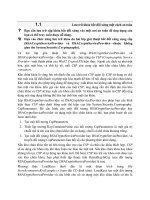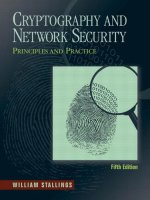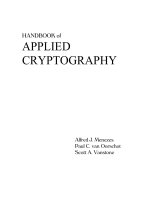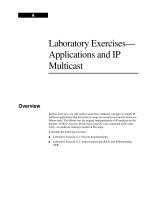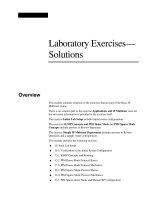197072216 cryptography exercises
Bạn đang xem bản rút gọn của tài liệu. Xem và tải ngay bản đầy đủ của tài liệu tại đây (314.34 KB, 94 trang )
Cryptography Exercises
1
Contents
1 source coding
3
2 Caesar Cipher
4
3 Ciphertext-only Attack
5
4 Classification of Cryptosystems-Network Nodes
6
5 Properties of modulo Operation
10
6 Vernam Cipher
11
7 Public-Key Algorithms
14
8 Double Encryption
15
9 Vigenere Cipher and Transposition
16
10 Permutation Cipher
20
11 Substitution Cipher
21
12 Substitution + Transposition
25
13 Affine Cipher
27
14 Perfect Secrecy
28
15 Feistel Cipher
38
16 Block Cipher
45
17 Digital Encryption Standard (DES)
46
18 Primitive Element
53
19 Diffie-Hellman Key Exchange
54
20 Pohlig-Hellman a-symmetric Encryption
58
2
21 ElGamal
59
22 RSA System
61
23 Euclid’s algorithm
65
24 Protocol Failure
66
25 Complexity
67
26 Authentication
68
27 Protocols
71
28 Hash Functions
73
29 Cipher Modes
78
30 Pseudo Random Number Generators
79
31 Linear Feedback Shift Register
80
32 Challenge Response
87
33 Application of error correcting codes in biometric authentication
89
34 General Problems
91
3
1
source coding
Problem 1.1. We consider 64 squares on a chess board.
(a) How many bits do you need to represent each square?
(b) In a game on a chessboard one player has to guess where his opponent
has placed the Queen. You are allowed to ask six questions which must
be answered truthfully by a yes/no reply. Design a strategy by which
you can always find the Queen. Show that you can not ensure the exact
position when you are allowed to ask five questions.
(c) How do you interpret your result in (b) together with your result in
(a)?
Problem 1.2. A language has an alphabet of five letters xi , i = 1, 2, ..., 5,
each occurring with probability 51 . Find the number of bits needed of a
fixed-length binary code in which:
(a) Each letter is encoded separately into a binary sequence.
(b) Two letters at a time are encoded into a binary sequence.
(c) Three letters at a time are encoded into a binary sequence.
Which method is efficient in the sense of bit per letter?
Problem 1.3. A language has an alphabet of eight letters xi , i = 1, 2, ..., 8,
with probabilities 0.25, 0.20, 0.15, 0.12, 0.10, 0.08, 0.05 and 0.05.
(a) Determine an efficient binary code for the source output.
(b) Determine the average number of binary digits per source letter.
Problem 1.4. Suppose a source outputs the symbols {a, b, c, d, e, f, g} with
probability {0.4, 0.2, 0.1, 0.1, 0.1, 0.05, 0.05}.
(a) Give a binary representation for these symbols and calculate the average representation length.
(b) How do you know that your representation has minimum average length?
4
2
Caesar Cipher
Problem 2.1. We consider a Caesar cipher and assume that the plaintext
message is in English. Decrypt the following ciphertext by giving a brief
explanation:
KN XM N SLKW JXM BF Y JW GJSIXF IRN Y XB
T W IKN XM W F SIT AJW M JQRN SLF SDIF D
Note: Use the following frequency distribution of the letters in the English
language for the cryptanalysis:
Table 1:
a
8, 05
n
7, 19
b
1, 62
o
7, 94
c
3, 2
p
2, 29
d
3, 65
q
0, 20
e
12, 31
r
6, 03
f
2, 28
s
6, 59
g
1, 61
t
9, 59
h
5, 14
u
3, 1
i
7, 18
v
0, 93
j
0, 1
w
2, 03
k
0, 52
x
0, 2
l
4, 03
y
1, 88
m
2, 25
z
0, 09
(a) What can be the main drawback of the substitution cipher given above?
(b) Caesar cipher is an example of classical cryptosystem. Is this statement
true? Why or why not?
(c) Steganography is the art and science of hiding information by embedding messages within other, seemingly harmless messages. Take the
third letter in each word of the encrypted message above and find the
emerging message.
5
3
Ciphertext-only Attack
Problem 3.1. We consider a ciphertext-only attack on a substitution cipher
and assume that the plaintext message is in English. Decrypt the following
ciphertext by giving a brief explanation:
XT HQT XJST RF Y Y JW M T BKF W
What can be the main drawback of the substitution cipher given above?
Problem 3.2. We consider a ciphertext-only attack on a substitution cipher
and assume that the plaintext is in English. Decrypt the following ciphertext:
ynyqj
Hint: Use the frequency distributions of the letters in English language in
table 1 for the analysis.
6
4
Classification of Cryptosystems-Network Nodes
Problem 4.1. Suppose that we have the following network nodes A, B, C
and D (Figure 1):
Figure 1:
C
B
A
D
(a) How many keys do we have to generate such that A, B and C can
communicate with D in a bidirectional secure way using a symmetric
encryption algorithm?
(b) We replace the symmetric encryption algorithm with a public key system. How many public keys do we have to generate in this case such
that A, B and C can communicate with D in a bi-directional secure
way?
(c) Suppose that we have 8 nodes in a network. How many symmetric keys
do we need such that every pair of nodes can communicate in a safe
way?
Problem 4.2. (a) Suppose that we have a network with 10 nodes. How
many different keys do we have to generate such that every pair of
nodes can communicate in a bi-directional secure way using classical
cryptosystem?
(b) We replace classical system with a public key system. How many different keys do we have to generate such that every pair of nodes can
communicate in a bi-directional secure way?
(c) Suppose that we extend the network with one more node. How many
new extra keys do we need to generate such that every pair of nodes
7
can communicate in a bi-directional secure way? (Calculate for classical
and public cryptosystems).
(d) What is your short conclusion or the interpretation of the results found
above?
Problem 4.3. (a) Suppose that we have a network with 6 nodes. How
many keys do we have to generate such that every pair of nodes can
communicate in a bi-directional secure way using the DES encryption
algorithm?
(b) Suppose that we extend the network with one more node. How many
new DES keys do we need such that every pair of nodes can now
communicate in a safe way?
(c) Instead of DES, we want to use RSA. How many Public keys do we
need such that every pair of nodes can now communicate in a safe way?
Problem 4.4. (a) Suppose that we have a network with 6 nodes. How
many keys do we have to generate such that every pair of nodes can
communicate in a bi-directional secure way using the RSA encryption
algorithm.
(b) Suppose that we extend the network with one more node. How many
new Public keys do we need such that every pair of nodes can now
communicate in a safe way?
(c) Instead of RSA, we want to use DES. How many keys do we need such
that every pair of 7 nodes can communicate in a bi-directional safe
way?
Problem 4.5. Suppose that we have the following network nodes: A, B, C,
D. Nodes can communicate over the links shown below (Figure 2).
Q1: How many keys do we have to generate such that nodes can communicate over the given links in a bi-directional secure way using the DES
encryption algorithm with node A and without node A?
Q2: Instead of DES, we want to use ElGamal public key scheme. How
many public keys do we have to generate such that nodes can communicate
over the given links in a bi-directional secure way with node A and without
8
Figure 2:
A
B
C
D
node A?
Answer the above questions for the following network nodes (Figure 3):
Figure 3:
A
B
C
D
Problem 4.6. Consider the figure 4 of a network with nodes A, B, C, D and
E. Arrows represent the communication in a bidirectional secure way.
9
Figure 4:
A
B
E
C
D
QA ) How many keys do we have to generate such that the nodes can communicate over the arrows in a bidirectional secure way using a symmetric
encryption algorithm?
QB ) We replace the symmetric encryption algorithm with a public key system. How many public keys do we have to generate in this case?
10
5
Properties of modulo Operation
Problem 5.1. Calculate the modulo operations given below:
ã 101 ì 98 mod 17 =
ã 75 mod 15 =
• 128 mod 7 =
• 7559 mod 63 =
• −7559 mod 63 =
• 755911 mod 63 =
• 17150 mod 151 =
• 1410 mod 197 =
• 68133 mod 323 =
• 1772 mod 73 =
• 773 mod 71 =
• 1310 mod 167 =
• 232 mod 5 =
• 864 mod 9 =
• 1242 mod 25 =
ã 163 ì 255 mod 23 =
ã 415 mod 17 =
11
6
Vernam Cipher
Problem 6.1. Consider a Vernam Cipher with the following encryption
scheme (Figure 5):
Figure 5:
Key sequence K (random)
Binary message M
C=M
K (xor operation)
Assume that a language has only three letters A, B and C. Their binary
representations are as follows: A = 000, B = 1111, C = 0011. Two words in
the language are encrypted with the same key sequence:
W 1 = 0101001110111010101100100
W 2 = 1011001010000000000101011
Determine the possible message pair.
Problem 6.2. The Vernam cipher is an example of a perfect stream cipher
(Figure 6):
For the probability P (ki = 0) = 0.5 and P (xi = 0) = 0.25 calculate P (yi = 0)
and P (yi = 1).
For the probability P (ki = 0) = 0.4 and P (xi = 0) = 0.3 calculate P (yi = 0)
and P (yi = 1).
For the probability P (ki = 0) = 0.5 and P (yi = 0) = 0.25 calculate P (xi = 0)
and P (xi = 1).
For the probability P (ki = 0) = 0.4 and P (yi = 0) = 0.3 calculate P (xi = 0)
and P (xi = 1).
For the probability P (ki = 0) = 0.5 and P (xi = 0) = 0.4 calculate P (yi = 0)
and P (yi = 1).
For the probability P (ki = 0) = 0.4 and P (xi = 0) = 0.4 calculate P (yi = 0)
12
Figure 6:
Binary key ki
Binary message x
i
y =x
i
i
K
i
and P (yi = 1).
For the probability P (ki = 0) = 0.6 and P (xi = 0) = 0.6 calculate P (yi = 0)
and P (yi = 1).
Problem 6.3. Suppose that we use the following simple encryption (Figure
7):
Figure 7:
Random bit stream R
C= M
R
Binary message M
A language has only two words: A = 111 and B = 0000. Two sentences
in the language are encrypted with the same random binary sequence R.
The first sentence S1 is encrypted as 011101101001000111001 and the second
sentence S2 is encrypted as 011010110110100111110. Find good candidates
for the original sentences.
Problem 6.4. a) Consider the following letter encodings:
13
letter
encoding
A
000
E
I
001 010
M
O
011 100
R
101
T
V
110 111
A message M = M ARIO is Vernam encrypted into ciphertext C =
AOAM V ; C = M ⊕ K where ⊕ shows modulo 2 XOR operation. Find the
corresponding encryption key. Provide details of your cryptanalaysis.
b) Consider the following two ciphertexts C1 = IEEIA and C2 = ORV RO
that are obtained from messages M1 and M2 respectively under the vernam
encryption and the same encryption key. Encrypted messages are two names.
Let us denote with mi,k the kth letter in message Mi . The following is known
about messages (names): m1,1 = R and m2,4 = T . Using this information,
try to recover messages M1 and M2 , as well as the encryption key. Provide
details of your cryptanalysis.
14
7
Public-Key Algorithms
Problem 7.1. Encrypt the message ’encoding’ using the double Transposition. Choose Key1 and Key2 as ’exam’ and ’study’.
Problem 7.2. A double transposition cipher uses as first keyword ’exam’
and as second keyword ’topic’.
Find the plaintext corresponding to the ciphertext C = isthastties.
Problem 7.3. Decrypt the ciphertext:
HRDY M IP U U N EOBP Y EAM T P OAK
using Double Transposition with keys K1 = CRY P T O and K2 = M ON EY .
15
8
Double Encryption
Problem 8.1. We consider double encryption of a private-key algorithm in
order to increase the security, such that: y = e2 (e1 (M )). Assume two ciphers
are given as:
e1 (x) = a1 .x + b1
e2 (z) = a2 .z + b2
where x and z represent the input message, a{1,2} and b{1,2} are the coefficients.
Show that there is a single cipher e3 (M ) = a3 .M + b3 which performs
exactly the same encryption (and decryption) as the combination e2 (e1 (M )).
16
9
Vigenere Cipher and Transposition
Problem 9.1. (a) For a transposition cipher the letter frequency remains
unchanged. (yes/no)?
(b) The number of different transposition ciphers for a binary word of
length 4 is . . . . . . . . . .
(c) A transposition cipher destroys dependency between letters.
Problem 9.2. Encrypt the message below using the following methods. Assume the English alphabet.
Supplieswillarrivetonight
1. Vigenere with key=system.
2. Double Transposition with key1=make, key2=stand.
What is the main advantage of Vigenere cipher over Caesar cipher?
What is the main goal of the transposition?
Why is it stronger to apply double transposition instead of single transposition?
Problem 9.3. A Vigenere type of cipher is given as follows:
Plaintext space X = {0, . . . , 25}.
Ciphertext space Y = {0, . . . , 25}.
Key space K = {0, . . . , 25}.
Encryption function is defined by:
E(X, K) = (X + K) mod n.
The following alphabet X = {A, B, . . . , Z} are identified with the natural
numbers.
(a) Determine the decryption function.
(b) Encrypt the following text by using the key ”hello” and assuming (as
usual) that n = 26.
Write your answer with a block of length 5 and ignore spaces, dots and
commas. (Show your steps briefly!)
M r. P resident,
I am delighted to accept your of f er.
17
Figure 8:
modulo 26
Plaintext
D
Ciphertext
D
Delay elements
Problem 9.4. Consider a Vigenere type of cipher with the encryption scheme
given in Figure 8.
(a) D represents the delay elements in time where Ci and Pi are the ciphertext and plaintext with the time index i. Write the encryption function
from the figure 8.
(b) Determine the decryption function.
(c) Draw the equivalent decryption implementation.
Problem 9.5. Suppose the message
SSDT T RRN N RICN AW COILOAT HKIU SGY IT AT OAAEU N
was encrypted using double transposition. Find the keys as well as the plaintext message. Hint: The keys belong to the set
{SY ST EM S, EN GIN EERIN G, U N IV ERSIT Y,
ESSEN, DU ISBU RG, CRY P T OGRAP HY }.
Problem 9.6. A vigenere type of cipher is given by the rule:
Ci = Pi + Pi−2 modulo 26
where Ci and Pi are ciphertext and plaintext symbols at time i, respectively.
It is implemented with two delay elements as shown in figure 9.
Give the rule for deciphering and draw the equivalent implementation to
decipher the ciphertext.
18
Figure 9:
modulo 26
Plaintext
D
Ciphertext
D
Delay elements
Problem 9.7. Decrypt the cipher text ICP EY DRCT EP DRHIEA using
the following methods, and the given keys. The alphabet is given by A = 1,
B = 2, . . . , Z = 26. (Note: The plain text may not be a readable message).
(a) Vigenere (Key = CRY P T O).
(b) Double Transposition (Key1 = CRY P T O, Key2 = ESSEN ).
Problem 9.8. We consider a Vigenere type block cipher system. You must
choose your key according to the last 4 letters of your surname. (Ex: Name:
Mengi, Key: engi) Encrypt the following given messages:
1. spyincountry
2. exam
Hint: A, B, C, D, E, F, G, H, I, J, K, L, M, N, O, P, Q, R, S, T, U, V,
W, X, Y, Z. (A=0,.., Z=25).
Problem 9.9. A Vigenere type of cipher is given by the rule: Ci = (Pi +
Ci−1 +Ci−2 ) modulo 26, where Ci and Pi are ciphertext and plaintext symbols
at time i, respectively. It is implemented with 2 delay elements as shown in
figure 10:
19
Figure 10:
Plaintext
+
modulo 26
Ciphertext
Delay elements
Give the rule for deciphering and draw the equivalent implementation to
decipher the cipher text.
20


